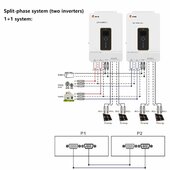42OhmsPA
What's in a title?
It will either be the Loads from each inverter to a polaris connector to 100A double pole or the loads from each inverter to there own 60A breaker.How are you connecting the two wires on L1 and the two wires on L2 from each inverter?
I don't think I've ever seen a 100A quad breaker.
Same, that's why I'll likely end up using 2 60A double pole.I prefer something easily sourced, carried by many vendors so you can shop for the deal and is cheap.
I already have a spare 100A double pole I bought and never used. Actually I will end up using that in the other panel.The stacked lugs are cheap, about $7 each. Takes 2. Small breaker panel with 80A to 100A double pole (if the inverters do output fully in parallel of 10Kw per leg). The breaker will cost more than the panel.
I'll draw up a better diagram tomorrow at work during one of my highly productive Teams meetings...




